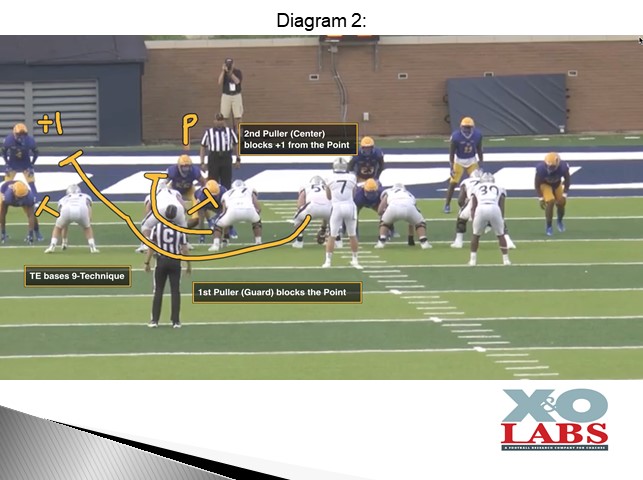By Mike Kuchar with Sanders Davis
Offensive Line Coach
Rice University (TX)
Twitter: @SandersDavis225
At Rice University, the offensive mindset has shifted from being a pure outside zone team to being more pin and pull based. It’s essentially supplemented wide zone and has been the perfect complement for the tight zone concept, the Owls top run scheme since head coach Mike Bloomgren took the program over in 2018. Because of the success of tight zone, which averaged nearly six yards a carry last season, there became a continual presence of tight 3-techniques at the line of scrimmage working straight through the Guard’s sternum and getting vertically. The Pin and Pull advantage are having angles with those defenders on pin blocks. “Teams start to play a lot more aggressive, a lot more downhill and thicker through offensive lineman,” said offensive line coach Sanders Davis. “People want to dive into the C or D gap, so we take advantage of that by pinning them and separating the defense. It takes advantage of how they want to try to attack our inside zone stuff.”
It’s also been a good complement to Power, another Bloomgren favorite. With a wide 9-technique outside a tight end/wing formation, a simple answer would be to let the tight end block out and fold the F underneath for a safety.
Call System:
One of the challenges in varying the back alignment is communicating the back alignment. For Rice, which is a West Coast system, the call system is a two-number system. The first digit tells back where he is aligning- whether it be in Pistol, in “I”, coming across the quarterback or on the same side. The second number is the direction of the concept, while the third number is the play concept. For example, “96 Power,” denotes the back being in Pistol (9) running to the right (6) in the Power concept. So, when the back alignment is altered, so is the numbers in the call.
First Puller Rules:
One of the complexities in the Pin/Pull scheme is determining who the first puller is. The first puller is responsible for the kick, the second puller is responsible for the point.
Base install will denote the following:
- If play side Tackle blocks down- Guard is the first puller
- If the Tackle is pulling, he’s always first.
- If there is no 3-technique, the Tackle knows he’s the first puller.
- If the Center is pulling, he’s always second.
So, essentially, it’s the Guard who needs to figure out if he’s the first or second puller. “Pullers need to know if they are the first puller or the second puller and if they are responsible for the point or plus one of the point,” said Coach Sanders. “If you know those two things, you can block this play a ton of different ways.”
Play Side 9-Technique Methodology:
Defenses work tirelessly to produce a hard edge at the D gap, which forces the first puller to recognize and block force quickly. Rice has two answers to these issues. The first of which is the hard “G” play, telling the first puller to kick the 9-technique while the second puller works inside the kick to the point linebacker.

Another build-in is switching responsibilities of pullers. It’s done with a “Hard 9-technique” call so that the first puller now blocks the point, and the second puller blocks the plus one defender. Of course, this can only be implemented with the confidence that the tight end can handle the D gap defender by himself.










